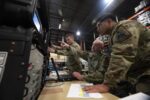Germany is expected to receive its first NH90 Sea Tiger anti-submarine warfare (ASW) helicopter by the end of 2025. Developed as a navalized variant of the NHIndustries NH90 platform, this rotorcraft will replace the aging Westland Sea Lynx Mk88A fleet in German service. The program marks a significant modernization step for Germany’s naval aviation and enhances NATO’s collective ASW capabilities in the Baltic and North Atlantic theaters.
Sea Tiger Program Overview
The NH90 Sea Tiger is a specialized ASW and anti-surface warfare (ASuW) variant of the NFH (NATO Frigate Helicopter) version of the NH90 platform. It was selected by the German Ministry of Defence in November 2020 under a €2.7 billion procurement contract for 31 helicopters. The aircraft are being developed and produced by NHIndustries—a consortium composed of Airbus Helicopters (62.5%), Leonardo (32%), and Fokker Aerostructures (5.5%).
The Sea Tiger will serve aboard German Navy frigates and is designed to operate in high-threat maritime environments with advanced sensors and weapons tailored for submarine hunting and surface strike missions.
Key Capabilities and Sensor Suite
The NH90 Sea Tiger integrates a comprehensive suite of mission systems optimized for ASW/ASuW roles:
- Thales FLASH Compact Dipping Sonar: A low-frequency active sonar system capable of detecting quiet submarines at extended ranges.
- Sonobuoy Processing System: Supports deployment and processing of passive/active sonobuoys for wide-area underwater surveillance.
- Leonardo LEOSS-T Electro-Optical System: Provides day/night imaging with laser rangefinding for target identification.
- Advanced ESM Suite: Enables electronic intelligence gathering and threat warning from radar emissions.
- Tactical Data Links: Link-11/16 compatibility ensures interoperability with NATO C4ISR networks.
The aircraft also features automatic blade folding for shipboard storage, corrosion-resistant materials for maritime operations, and full fly-by-wire flight controls with four-axis autopilot—enhancing safety during deck landings in rough sea states.
Weapons Integration
The Sea Tiger is armed with an array of weapon systems tailored to both submarine prosecution and surface engagement:
- MU90 Impact Lightweight Torpedoes: The primary ASW munition, capable of engaging deep-diving submarines at long range with high probability of kill.
- Mistral or Stinger Air-to-Air Missiles (optional): For self-defense against aerial threats during overwater operations.
- AIR-to-Surface Missiles (Future Growth): Potential integration paths include MBDA Marte ER or Spike ER missiles for surface strike missions.
This multi-role loadout enables flexible mission profiles including escort duties, area denial operations near chokepoints like the GIUK Gap or Baltic approaches, as well as convoy protection against hostile submarines or fast attack craft.
Status of Production and Delivery Timeline
The first airframe is currently undergoing final assembly at Airbus Helicopters’ Donauwörth facility in Bavaria. According to statements from both Airbus Defence & Space and Germany’s BAAINBw procurement agency as of October 2025, flight testing is scheduled to begin in Q1 2026 following ground trials later this year. However, initial delivery remains slated for late Q4 2025 under a pre-delivery configuration suitable for training purposes at Nordholz Naval Air Base.
The remaining helicopters will be delivered incrementally through 2030. The German Navy’s Marinefliegergeschwader (MFG) will operate them primarily from Sachsen-class (F124) frigates and future F126-class multi-role combat ships currently under construction by Damen Naval.
NATO Role and Strategic Implications
The introduction of the Sea Tiger significantly enhances Germany’s contribution to NATO’s maritime situational awareness in contested waters such as the Baltic Sea—an increasingly strategic flashpoint since Russia’s invasion of Ukraine. With enhanced ASW reach from forward-deployed frigates or standing NATO Maritime Groups (SNMGs), Berlin reinforces deterrence posture along key sea lanes between Scandinavia, Poland, and Western Europe.
This capability also fills critical gaps left by retiring platforms across European navies—many still reliant on legacy Lynx or Super Puma derivatives with limited sensor integration or data link compatibility. As part of broader NATO interoperability efforts—including P-8 Poseidon deployments from Norway—the Sea Tigers will integrate into joint task forces conducting persistent undersea surveillance against Russian Kilo-class or Yasen-class submarines operating near key infrastructure like transatlantic cables or LNG terminals.
Challenges Ahead: Logistics & Training Pipeline
A key concern remains logistics supportability given past issues with NH90 variants regarding spare parts availability and maintenance complexity. The Bundeswehr has acknowledged these risks but claims that lessons learned from previous TTH/NFH programs have been factored into sustainment planning via performance-based logistics contracts with Airbus Helicopters Deutschland GmbH.
Pilot conversion training has already begun using simulator modules adapted from existing NFH variants operated by France and Italy—with German-specific software updates pending certification in mid-2026. Initial crews are drawn from MFG3 “Graf Zeppelin,” which previously operated Lynx helicopters on Baltic patrols since the Cold War era.
A Modernized Maritime Rotorcraft Fleet Emerges
The arrival of the first NH90 Sea Tigers marks a generational leap forward in Germany’s rotary-wing naval aviation capabilities—bridging decades-old gaps in airborne ASW coverage while aligning Berlin more closely with allied maritime doctrines emphasizing distributed lethality through forward-deployed sensors-and-shooters architecture.
If program milestones hold through final operational capability (~2030), Germany will field one of Europe’s most modern shipborne helicopter fleets—positioned not only to defend national waters but also contribute meaningfully to collective defense across NATO’s northern flank amid rising tensions beneath contested seas.










